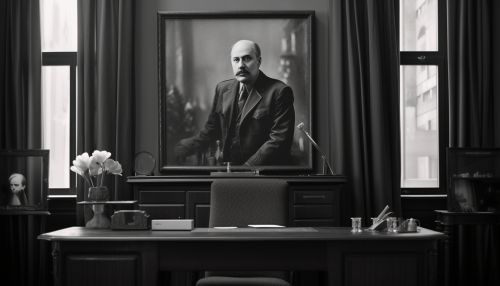Joseph Stalin
Early Life
Joseph Stalin, born as Ioseb Besarionis dzе Jugashvili, was born on 18 December 1878 in Gori, a small town in the Russian Empire's province of Tiflis, now present-day Georgia. His parents, Besarion Jughashvili and Ekaterine Geladze, were impoverished peasants. Stalin's father was a cobbler, and his mother was a housemaid. Stalin was the couple's only child to survive infancy.
Education
At the age of seven, Stalin contracted smallpox, which left him with lifelong facial scars. Despite his humble origins, Stalin's mother, a devout Orthodox Christian, managed to secure him a place in the Gori Church School, a prestigious institution where he learned to read and write in Russian. In 1894, he received a scholarship to the Tiflis Theological Seminary, a training institution for priests in the Russian Orthodox Church. However, he was expelled in 1899 for missing exams, although there are claims that he was expelled for revolutionary activity.
Political Activism
After leaving the seminary, Stalin became involved in the revolutionary movement against the Russian monarchy. He joined the Russian Social Democratic Labour Party in 1899 and later sided with the party's radical Bolshevik wing, led by Vladimir Lenin. Stalin participated in various revolutionary activities, including bank heists and the organization of strikes and protests, which led to his repeated arrests and exiles.
Rise to Power
Following the October Revolution in 1917, which led to the overthrow of the Russian Provisional Government, Stalin was appointed as the People's Commissar for Nationalities' Affairs. His close association with Lenin helped him rise through the ranks of the newly formed Soviet Union. After Lenin's death in 1924, Stalin emerged as the leader of the Soviet Union, following a power struggle with other prominent Bolsheviks.


Stalin's Rule
Stalin's rule over the Soviet Union, often referred to as the Stalin era, was marked by a series of five-year plans aimed at transforming the Soviet Union from a peasant society into an industrial superpower. His policies, including forced collectivization of agriculture, led to widespread famine, particularly in the Ukraine region, an event known as the Holodomor. Stalin's government was also characterized by mass repressions, hundreds of thousands of executions, and purges within the Communist Party, a period known as the Great Purge.
World War II
During World War II, Stalin maintained a non-aggression pact with Nazi Germany, known as the Molotov-Ribbentrop Pact. However, in 1941, Germany violated the pact and invaded the Soviet Union. Despite initial setbacks, the Soviet Union managed to halt the German advance and eventually captured Berlin in 1945, marking the end of the war in Europe.
Death and Legacy
Stalin died on 5 March 1953, leaving a legacy that is still widely debated today. While he transformed the Soviet Union into a world superpower, his rule was marked by widespread atrocities and human rights abuses. Despite attempts at de-Stalinization by his successors, Stalin remains a controversial figure in the history of the 20th century.
